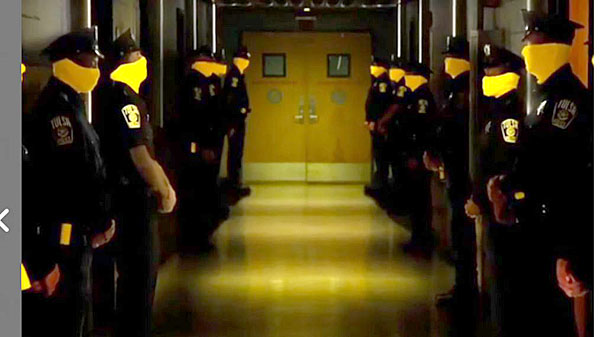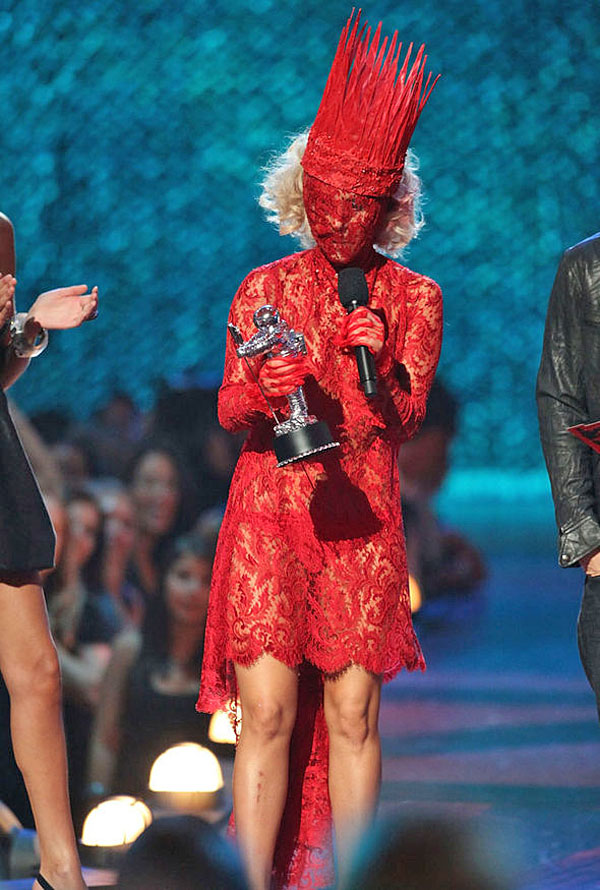
In the wake of the “look at me” era, there’s some evidence that the tide may be beginning to turn. Completely hiding one’s face (and often head) in public, as well as on social media, is having a moment. Yes, it’s the Halloween season, but these micro-trends roots were planted way before the ghosts and goblins came out to play — for a far creepier reason.
In the fashion or fetish industry; on TV (“The Masked Singer,” a game show featuring contestants guessing what famous performer is in costume; “Watchmen,” HBO’s adaptation of the graphic novel/comic book series) as well as in the protest arena (Hong Kong, Antifa) covering your face and head for other than religious reasons is a thing.

Photo: Vogue.com
It’s hard to believe it’s been a decade since the always-ahead-of-the-pack Lady Gaga accepted her Moonman at the 2009 MTV Video Music Awards in a red lace Alexander McQueen ensemble featuring a matching red lace identity face screening mask.

Photo Vogue.com
Maison Martin Margiela, an early proponent of masks, featured beautifully embellished full face and head obscuring crystal masks for Fall/Winter 2012’s Haute Couture collection. Some might suggest that Margiela wanted to have the focus on the clothes rather than on the model’s faces, however that rings false because the masks were the chief focal point in a way that normal hair and makeup could never be.

Photo Vogue.com
Proof that the mask was the star of the show — Margiela sent a model out garbed in an extended mask draped like a breastplate — evoking chain mail templar armor (think a “jeujed up” version of Monty Python’s Holy Grail, perhaps going to the gallows) — and a pair of unremarkable faded boyfriend style jeans.

Fast forward to last month’s Paris Fashion Week when none other than the ultra flamboyant Cardi B went incognito in Richard Quinn’s Fall/Winter 2019. She totally obscured her persona in his floral printed ensemble complete with matching head and face covering as she struck a pose in front of the Tour Eiffel. If Cardi B is cool with cloaking herself, perhaps a Kardashian will follow suit?

Photo: Vogue.com
Last week the up and coming brand Besfxxk (“bespoke + fxxked up”), currently available at Bergdorf Goodman and seen on Linda Fargo, took Shanghai fashion week by storm. Designers Bona Kim and Joe Hyuk Lim (who previously featured models with their hair combed over their faces) styled their 2020 spring collection runway models with “bank robber style” stocking caps. Not only does this retain model privacy, but it also negates the need for any hair and makeup (let alone a pretty face). In this case, you could see that the interestingly juxtaposed, mixed-media clothes were taking center stage.

Photo: Vogue.com
Speaking of China, face masks have come to the fore there as a result of the Hong Kong protests. Activists in Hong Kong wear masks and use laser pointers to confuse government surveillance aimed at identifying those demonstrating. China has a frightening and increasingly robust system of facial recognition that is used for many social control purposes.
In the nearly adjacent city of Shenzhen the mass transit system scans your face to log the fare, and elsewhere in the country, there are systems employed that spy on any students that doze off in the classrooms, count permanent demerits for jaywalkers and identify the patterns, routines, movements and associations of the many denizens of the country’s cities. A quick glance at that dystopian reality ought to spur you into an audit of your own exposure to similar vile tech practices.

The Hong Kong protestors that do not wear masks run a substantial risk of being arrested, or that agents of the state will place their name, face, and contact information for themselves and next of kin on websites intended to help counter-protestors conduct harassment. The government has put into place a ban on masks, hoping to stymie the identity obfuscation –identical laws exist for most of the major municipalities of the United States. As a result, the resourceful rioters of Hong Kong have come up with a few non-mask methods of protecting their face. Most fashion savvy of these is the hair balaclava—technically not a mask, yet covering all but the eyes and mouth.

Traveling but not quite ready to disguise yourself behind a hirsute face? These same sinister technologies are beginning to be deployed at U.S. airports—none of which increase security, but all kill privacy. Think Clear is a time-saving boon to your travel routine? Guess again! Signing up for Clear is putting your biometric data (scan of your face) into the same sort of government database that convicts spend their life trying to get off, and you’re paying for the privilege. Not to mention that so many have willingly submitted that the security line is often just as long.
Also, at the airport, beware of a new program being rolled out, which has you scan your face at the boarding gate. (So far you can still avoid this by instructing the ticket agent to use only your boarding pass). If you’re traveling internationally, be prepared to face similar scrutiny when you leave and enter the country.
Courtesy of a new Presidential Executive Order, you must scan your face when you go through passport control as part of the Biometric Entry/Exit program operated by Customs and Border Protection. In some rare cases, they will also collect fingerprints, completing the impression that this is an arrest with a mugshot. You can still avoid this by requesting an alternative screening when you are at the gate, and when you are in line for immigration processing on your return.

Think you can thwart these invasive practices traveling by car? If you cross a bridge or tunnel into New York City, make sure you “strike a dab” before the seizure-inducing flashing lights at the toll (those photos go in the NYPD database).
For those already boycotting Hudson Yards, here’s another reason to stay away. There are facial recognition systems in multiple places (like the kiosks) storing your biometric data for life. Of course, there are easily avoidable examples of this technology on phones and computers that use your face or fingerprint to sign in. Many photo applications like the one built into the newest iPhones (and enabled by default in Windows 10 photos) also compromise your friends, family, and anyone else that you have a photo of. (These can be disabled if you peruse the settings menus, reading the prompts carefully).
You never know where this information will go or who will get access. India has a national biometric database that keeps getting hacked (scammers sell the private info of citizens online for impersonation and bank fraud); in 2015 The U.S. Office of Personnel Management (which handles payroll, promotion, pension and address information for most federal government employees) was hacked by Chinese hackers, exposing the private information of 21.5 million people.
On June 20th, 2019, it was revealed that Customs and Border Protection failed to protect 100,000 travelers’ photos from another facial recognition program ( see Bloomberg article). Remember: you can always get a new password, but you can never get a new face.
All of this makes you think—maybe the mask wearers are on to something.
